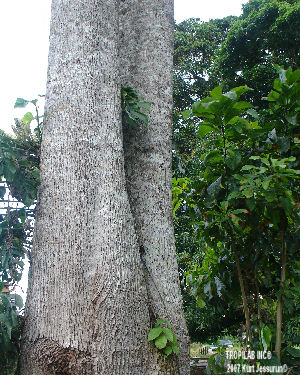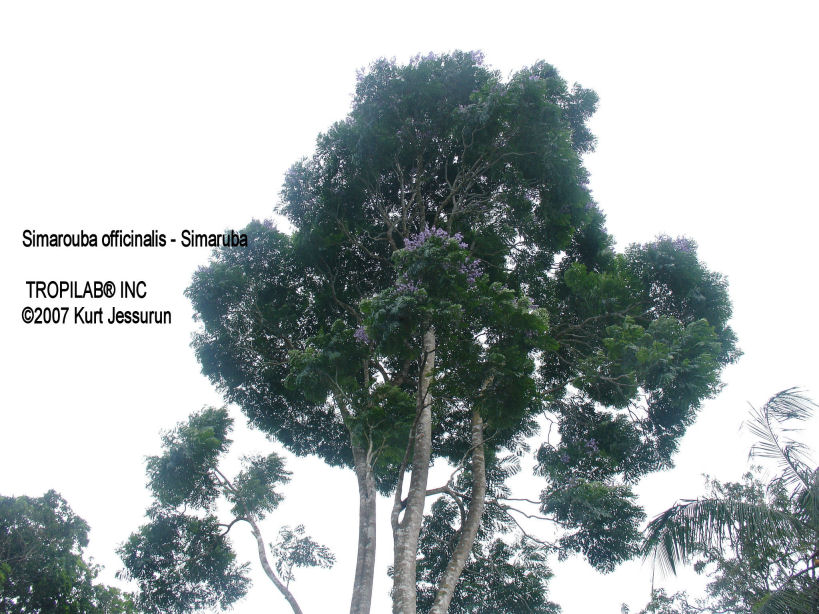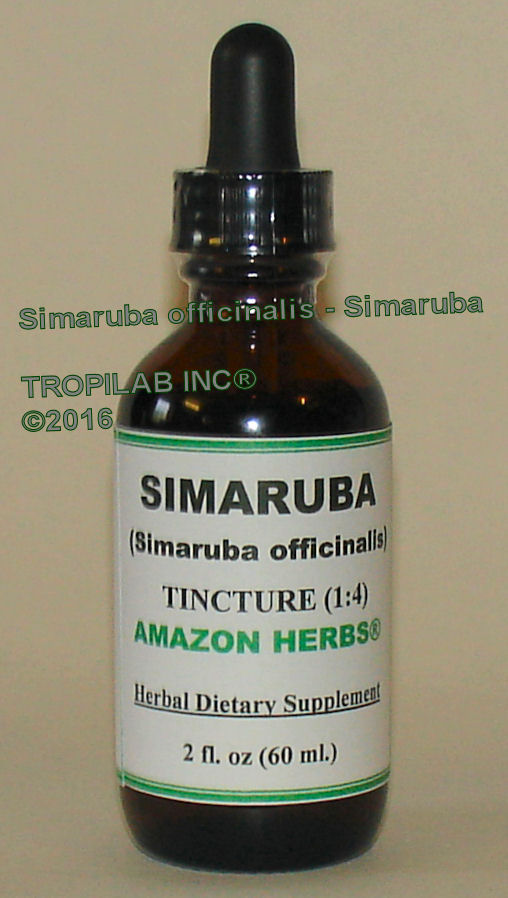 |
 |
|
SIMARUBA TINCTURE (tinctura Simaruba officinalis) from AMAZON HERBS® |
 Overview
Overview Simaruba (Simarauba) is a tall tree, indigenous to the Amazon rainforest, growing up to more than 60 feet in height; it has a smooth grayish bark. The parts that are used medicinally are the inner-bark and leaves. The bark is odorless, difficult to powder, and very bitter. The powdered or chopped up bark is used for the following conditions: infections (candida yeast, parasitic, respiratory) and prostatitis (swelling and inflammation of the prostate gland). Quassinoids, (phytochemicals of the Simaroubaceae plant family) responsible for the anti-amebic and anti-malarial properties, have also shown to possess active anticancer properties. In Traditional Medicine in Suriname, it is used in the latter stage of dysentery*, when the stomach is not affected. In Brazil it is the foremost natural remedy against chronic and acute dysentery. It restores the lost tone of the intestines, promotes the secretions, and disposes the patient to sleep. For its use, it has been called "Dysentery bark" but is also a haemostatic agent (stops bleeding). It is also employed in the treatment of malaria and used as a tonic. Simarouba bark tincture & medicinal tea can be the first line of defense for amebic dysentery and diarrhea. It's also a natural remedy against viruses. Constituents Phytochemicals: Anthraquinones, Ascorbic - acid, Beta - carotene, Beta - sitosterol, Beta - lapachone, Calcium, Chromium, Chrysophanic - acid, Cobalt, Fat, Fiber, Iron, Lapachol, Magnesium, Naphthoquinones, Niacin, Phosphorus, Potassium, Protein, Riboflavin, Selenium, Silicon, Thiamin, Zinc. Pharmacology  The quassinoids, responsible for the anti-amebic and antimalarial properties, have
also shown in clinical research to possess active cancer-killing properties.
The quassinoids, responsible for the anti-amebic and antimalarial properties, have
also shown in clinical research to possess active cancer-killing properties.Simaruba has the ability to kill the most common dysentery-causing organism, Entamoeba histolytica, as well as two diarrhea-causing bacteria, Salmonella and Shigella. Research confirmed strong antiviral properties of the bark in vitro against herpes, influenza, polio, and vaccinia viruses. Dosage  Tincture: 1 - 3 ml daily
Tincture: 1 - 3 ml daily Infusion (herbal tea): 1 - 2 cups / daily. Side effects and/or interactions Nausea and dizziness; in large doses it produces sickness and vomiting. Do not take while pregnant or breast feeding. *Dysentery: an inflammatory disorder of the intestine, especially of the colon, resulting in severe with fever and abdominal pains. If left untreated, it can be fatal. The most common cause of the disease in developed countries is infection with a bacillus of the Shigella group. For more information on Simaruba, go to the "Simaruba plant" page. References Effect of the quassinoids glaucarubolone and simalikalactone D on growth of cells permanently infected with feline and human immunodeficiency viruses and on viral infections. Morre, D.J., et al. Life Sci. 1998; 62(3): 213-9. Anti-tuberculosis activity of quassinoids. Rahman, S., et al. Chem. Pharm. Bull. 1997; 45(9): 1527-9. Search for new antiviral agents of plant origin. Kaif-A-Kamb, M., et al. Pharm. Acta Helv. 1992; 67(5–6): 130–147. The isolation and structure of 13,18-dehydroglaucarubinone, a new antineoplastic quassinoid from Simarouba amara. Polonsky, J. Experientia. 1978; 34(9): 1122–23. Antitumor plants. IV. Constituents of Simarouba versicolor. Ghosh, P. C., et al. Lloydia. 1977; 40(4): 364–69. Potential anticancer agents VI. Constituents of Ailanthus excelsa (Simaroubaceae). Ogura, M. et al. Lloydia. 1977; 40(6): 579–84. The above presentation is for informational and educational purposes only. It is based on scientific studies (human, animal, or in vitro), clinical experience, or traditional usage. For many of the conditions discussed, treatment with prescribed (RX) or over - the - counter (OTC) medication is also available. Consult your doctor, practitioner, and/or pharmacist for any health problem and before using dietary supplements or before making any changes in prescribed medications. |
|
For the right freight rate, please visit our Webstore page! |
|
TROPILAB® INC copyright disclaimer |